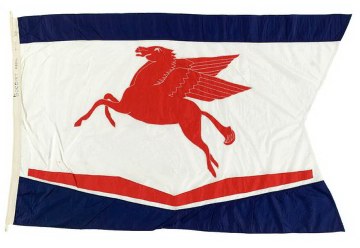Auke Visser's Other Esso Related Tankers Site | home
SOCONY- History in short
SOCONY
The house flag of Socony Mobil Co. Inc, New York. A white swallow-tailed burgee with blue borders. There is a red, winged horse with a red stripe below in the centre. The flag is made of nylon with a cotton hoist and is machine sewn.
A terylene halyard is attached. The Pegasus flag was introduced shortly after the merger between Mobil and Standard Oil in 1931.
Socony Mobil’s history dates from the late 19th century as part of American John D. Rockefeller’s oil giant Standard Oil.
Rockefeller, along with Maurice B. Clark and Englishman Samuel Andrews, founded Standard Oil in 1870 in Cleveland, Ohio after investing in an oil refinery in 1863. Following a trust agreement in 1882, the Standard Oil Company of New York was created, the predecessor to Socony-Vacuum and later the Mobil Corporation. In the next decades, the company spread its business to Europe and Asia, and employed the use of large ‘kerosene clippers’ to transport their material overseas. 1911 marked the end of the giant consortium of 34 Standard Oil companies after an antitrust suit forced Rockefeller’s conglomerate to split. Standard Oil Company of New York was now a spin-off company of the original Standard Oil, and became known as Socony (an acronym for its full name). In 1931, further changes were implemented when Socony merged with the Vacuum Oil Company to become Socony-Vacuum. Vacuum Oil Company was already selling a product called Mobilgas, and Socony’s Pegasus logo was adopted (a remnant of an old Standard Oil logo); these were the origins of the Mobil Oil Company’s name and logo. As with many other major oil companies at the time, Socony-Vacuum’s tankers were recruited to transport oil for the Allies during World War II. This caused a temporary
drop in business and expansion overseas. Socony-Vacuum employed special transport companies in Hong Kong and Canada during the war to oversee the transport of their American products through war zones and dangerous ports.
After World War II, Socony-Vacuum continued expansion and mergers with other oil companies in the United States and overseas. In 1955, the company dropped the 'Vacuum' and became Socony-Mobil, then finally just Mobil Oil in 1966. In 1960 the Mobil Chemical Company was formed as part of Mobil Oil, producing synthetic lubricants and other organic chemicals. After surviving the petrol crisis in the 1970’s and subsequent recovery in the 1980’s, Mobil Oil merged with Exxon Corporation in 1998 to form the ExxonMobil, currently the largest integrated oil and gas company in the world.
|
